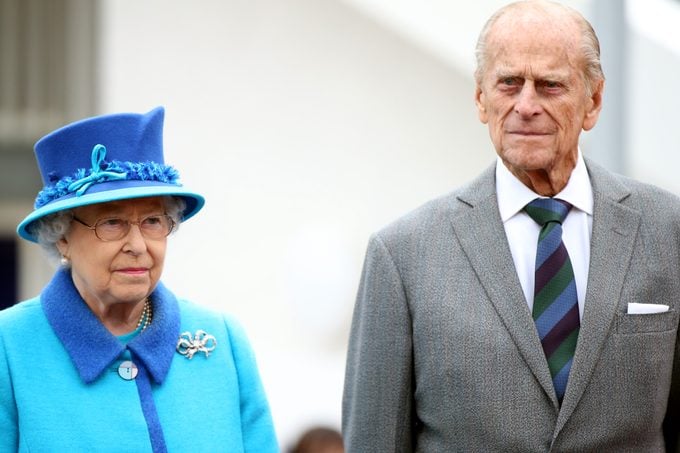The Shocking Rumor That’s Plagued Prince Philip for Decades
Updated: Jun. 07, 2021
Did Prince Philip orchestrate the death of Diana, Princess of Wales? Here's why that rumor doesn't ever seem to go away.

The death of Diana, Princess of Wales on August 31, 1997, at the age of 36 left the world reeling. Because Diana was beloved by so many and was such a sympathetic woman—a beautiful real-life princess who truly seemed to care about humanity, a young mother whose hopes of a happy marriage were dashed by her husband’s love for another woman—this would have been true regardless of the circumstances surrounding her death. But those circumstances—a fiery car crash in a Parisian tunnel just after midnight, her boyfriend, Dodi al Fayed, by her side—easily laid the groundwork for myriad conspiracy theories, including these 10.
Most, if not all, are premised on the same general distrust of powerful people on which nearly all conspiracy theories, in general, are premised. But there are few who hold more power (and more inexplicably), than the royal family, whose position derives from bloodlines, rather than from democracy, and which, over the centuries, has been associated with a fair amount of mystery and scandal. Of all the living members of the royal family, there are none quite so inexplicably powerful than Prince Philip, Duke of Edinburgh.
Prince Philip, the husband of Queen Elizabeth II, is not the king, and he wouldn’t even be a prince if it weren’t for the Queen’s generosity in creating him as one after she took the throne in 1952. Yet in being the Queen’s consort and the male counterpart of the head of the royal family, he holds incredible power—even if that power is more theoretical than actually wielded.
The relationship between Princess Diana and her father-in-law
Prince Philip and Princess Diana had a complex relationship. At times, they were “warm and close,” but there’s evidence she may have blamed him for encouraging his son, Prince Charles, in continuing his affair with Camilla Parker Bowles. Diana reportedly felt “attacked” by Philip when he tried to advise her with regard to her marital issues, and he reportedly felt misunderstood and unappreciated by her. But irrespective of the ups-and-downs of their relationship as in-laws, a power imbalance would always remain: Prince Philip is the husband of the Queen and the father of the heir apparent to the throne. His loyalty to his son, to his wife, and to the monarchy would always trump his affection for his daughter-in-law.
And isn’t that sort of imbalance between power and affection at the heart of all juicy murder plots? Think: Julius Caesar, murdered by his friends and colleagues. Think: King Henry VIII’s plot against his wife, Anne Boleyn. In other words, the fact that Prince Philip and Princess Diana had a warm relationship doesn’t, itself, preclude conspiracy theorists from guessing Philip wanted Diana out of the way and did what he had to do to make that happen—and may actually provide fuel for conspiracy theorizing.
It was Mohammad al Fayed, the father of Diana’s lover, Dodi al Fayed, who put into words what many amateur conspiracy theorists may have been thinking: that Prince Philip ordered the death of Princess Diana because, with the Diana-Charles divorce finalized, there was no other way to control the behavior of the mother of the future king, Prince William. In particular, Mr. Fayed believed the royal family was opposed to Diana’s relationship with Dodi. Further, he believed Diana was pregnant with Dodi’s child and that Diana and Dodi would have wanted to marry in the near future, and the royal family had no way to stop it except by using their power and influence to orchestrate Diana’s murder (with Dodi as collateral damage).
All of that being said, there has never been a shred of evidence to support Mr. Fayed’s claims, and every official investigation into the death of Princess Diana has concluded it was an accident caused by the negligence of the driver of the car in which Diana was riding. But a lack of evidence doesn’t tend to do much to quell conspiracy theories. In fact, conspiracy theories would appear to thrive on a lack of evidence, which, itself might support the existence of a cover-up.
In this case, there was no surveillance footage of the crash, despite there being cameras in the tunnel in which the crash occurred. Witnesses shared contradictory accounts of what happened before and during the crash, including as to the existence of a white Fiat that might have been involved in the crash and a bright light that may have flashed just before the crash. In her emotionally distressed final weeks, Diana had even expressed a fear that she would be murdered, and in a car crash, no less.
When you’re a hammer, everything seems to be a nail, goes the old saying, and when it comes to processing celebrity deaths, it’s “human nature” to seek “reasons” that go beyond the “random, according to Pauline Maclaran, co-author of Royal Fever: The British Monarchy in Consumer Culture. “When you have icons, it’s very hard to believe that they can just come to an end in such a futile way.” And yet sometimes, that’s all it is: futile.
Every product is independently selected by our editors. If you buy something through our links, we may earn an affiliate commission.
